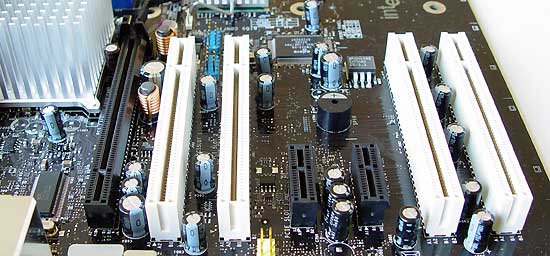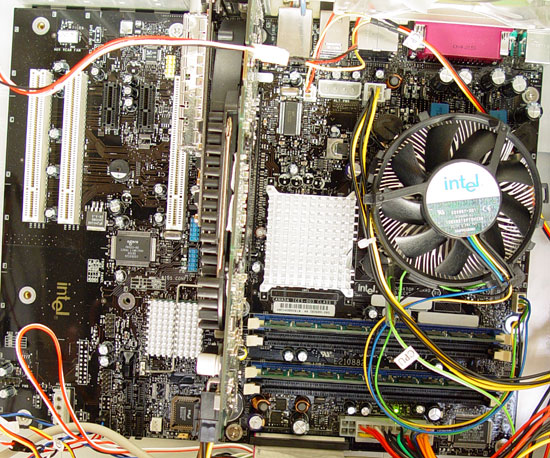Page 4
From a graphics/gamers point of view most exciting for us is of course that PCI-Expess technology is slowly replacing the older PCI and AGP ports, why? Bandwidth, it's all about bandwidth these days and the PCI-Express solution is a major step into the future. With up to 4GB/s of one-directional and 8GB/s of concurrent bandwidth, users are free to have high-speed graphics output. PCI Express significantly increases bandwidth between the central processing unit (CPU) and graphics processing unit (GPU). PCI Express can also deliver more power than the older AGP slot, the x16 slot can feed your graphics card directly with 75 Watts.
 To your outer left, the PCI-Express 16x port for your graphics card, the smaller ones are PCI-Express 1x.
To your outer left, the PCI-Express 16x port for your graphics card, the smaller ones are PCI-Express 1x.
Did you know that one PCI-Express lane (x1) has more bandwidth then your mainboard's entire PCI bus? PCI used to share that bus with all PCI devices, so a fast ethernet controller was capable of utilizing and stressing the entire PCI bus! That's a thing of the past as well as x1 PCI Express offers 500MB/sec full duplex over its own pipeline. No more sharing that bandwidth and this means better performance for all devices. Yes I'm all for the PCI Express bus.
|
D925XECV2 Desktop Board Details | |
| Form Factor |
ATX |
| CPU Support | Intel Pentium 4's with 800MHz & 1066MHz FSB in the LGA 775 Package |
| Memory | Up to 4 DDR2 533/400 DIMM's Supports up to 4GB of Memory DDR2 533 CL3 Timing Support |
| Integrated Audio |
|
| Network | GigaBit LAN |
| Expansion Slots |
|
| Peripheral Interfaces |
|
What's pretty cool is that Intel delivers the Intel's Desktop Control Center Software. This is a utility that allows you to monitor and tweak multiple features of the system platform. Here you can setup different bus speeds (overclock) and different modes of fan operation. What I like the most is that you can create customizable profiles so that you can setup a high performance configuration for gaming and a low noise configuration for Home Theater use. Pretty cool stuff.
Overclocking itself was not a big success, think in the area of a 10% overclock. This mainboard BIOS allowed some pretty decent tweaking functions, but since this is a reference board it's not worth the effort as the final product from selected manufacturers simply will be different, and thus so will be the results.
The following pages will show some tests we ran. As always I need to explain that this site's focus is targeted at gamers worldwide and so that will represent itself in the tests.

After installing it into a PC casing, sorry for that wire disorder.
